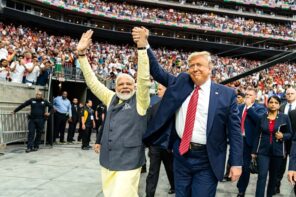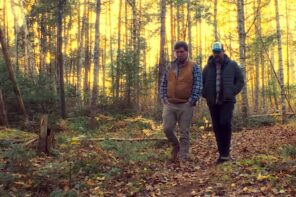Religion Dispatches recently sat down with Isaac Kamola, associate professor of political science at Trinity College, Hartford, and the director of the Center for the Defense of Academic Freedom at the American Association of University Professors (AAUP) to discuss how the backlash to CRT and DEI in higher education emerged as a coordinated far-right response to the racial justice uprisings of 2020.
In this conversation, RD gets the scoop on the soon-to-be-published report Manufacturing Backlash: Right-wing Think Tanks and the Legislative Attack on Higher Education [now published], which identifies the key actors behind this response, exposes their strategies to reimagine the university as a vehicle for far-right perspectives, and the robust political infrastructure they’ve built to advance the right-wing agenda.
We also learn why their ideas are so weak.
This interview has been edited for brevity. Stay tuned for a longer interview with Kamola coming out on Political Research Associates.
Thanks so much for speaking with us, Isaac. Your Manufacturing Backlash report comes out with the American Association of University Professors (AAUP) this week. In 120+ pages of detailed and rigorous research, you profile “eleven of the think tanks that have played a significant role executing this sustained culture war backlash against public education,” and the laws and policies they helped to shape. To jump in, what’s the central takeaway of your research?
The Manufacturing Backlash report looks at the 2021, 2022, and 2023 legislative cycles, and five different kinds of bills that have been introduced and sponsored almost exclusively by Republicans. These include academic gag orders that affect higher education, often known as anti-CRT or divisive concepts bills. Probably the best-known is the “Stop Woke Act” in Florida. These bills, which came out in 2021 in direct response to the Black Lives Matter protests, copy-paste large parts of Trump’s Executive Order 13950 which banned trainings around racial stereotyping in the federal government. So, right-wing activists and think tanks took that executive order and turned it into model bills and pushed it in dozens of states, affecting both K-12 and higher education.
We demonstrate in the report that the early versions of those bills affected campus trainings or school trainings and expanded in scope to affect curricula. These bills seek to silence discussions of race, gender, inequality, and any version of American history that’s different from the White founders, rational, and “divinely-inspired” America mythology that is so prominent on the Right. Those academic gag orders, as I understand them, are the first wave of legislation that deliberately targets higher education as a direct response to the Black Lives Matter protests and growing queer and trans visibility in American society.
The second wave [of four] is the anti-DEI bills, which rolled out starting in 2023 and became a defining part of the 2024 legislative cycle as well. Those aren’t trying to police speech in the classroom per se, because that [tactic] was running into legal issues on First Amendment grounds. Instead, they try to reshape what services schools provide to their students. These bills aim to create the language that talking about diversity, equity, and inclusion and talking about how to create more just education institutions are somehow these ideological political projects that so-called brainwash students.
Thank you for that. In the report you focus on 11 think tanks, and specific constellations of think tanks. Can you describe how you came to identify major players in those different categories of legislation that you just laid out?
When studying the influence of dark-money-funded institutions, we should always understand the findings as conservative estimates. Because of the way the tax documents work, it’s really hard to find all the funders. So, the 11 think tanks that we focus on really come out of what we were observing through those materials.
I was doing a deep dive into the bills and would look at who’s writing the model bills—it’s the same handful of players which includes prominent federal and state, and behind-the-scenes think tanks. The think tanks platforming the fellows who are writing the reports that criticize DEI and CRT—these are the same handful of groups that kept appearing over and over again. Think tanks like the Heritage Foundation and the Manhattan Institute are two really big and prominent think tanks on this particular issue. They have tens of millions of dollars (and, in the case of Heritage, more than $100 million) and are very, very influential in right-wing libertarian policy circles. They’re heavily influential in some of the worst legislation of the last few decades.
Then the final group that we look at (the twelfth group, if you will) is the State Policy Network (SPN), which grew out of the American Legislative Exchange Council (ALEC). SPN is the de facto model legislation mill that the Right set up to crank out anti-union, anti-Medicare, anti-social security, pro-voucher, pro-concealed carry bills. They realized that if they were going to generate state-level policy, they needed help implementing it in the states.
So, the State Policy Network is a kind of a “think tank of think tanks” that brings together the national, state-level, and specialized think tanks. SPN brings together hundreds of think tanks in a kind of an integrated, networked way that serves as a vehicle for funding and also for communication amongst each other, focusing on accreditation, litigation, journalism, and other areas of expertise.
How were you able to see those connections? Walk us through how you came to research the US Right’s creation and shaping of anti-CRT and anti-DEI policy and messaging.
Ralph Wilson came to me with his research about dark money in higher education that demonstrated how the careers of the provocateurs like Milo Yiannopoulos don’t exist without a Robert Mercer—the hedge fund financier who funded Cambridge Analytica and is a regular attendee of the Koch donor summits. So, if you take out Mercer, then Milo Yiannopoulos disappears.
Likewise, the student groups that bring them to campus are funded by the same people. The litigation groups that sue schools when they don’t allow Yiannopoulos, et al, on campus are funded by the same people. The media outlets that write these outrage stories are funded by the same people. Thus, this is a very, very small political network that actually shapes how people are talking about higher education.
Their manufactured narrative is that professors are indoctrinating and brainwashing students in the classroom and that students are woke and coddled—a narrative that then gets baked into our public discourse. We see the effect, for example, in the response to the International Court of Justice when they determined that Israel’s assault on Gaza likely constitutes a genocide and war crimes—the narrative that actually plays out in the American media is that these students are out of control and wild. This is a false narrative that’s been manufactured by these right-wing think tanks and right-wing media outlets.
This analysis that I just laid out was covered in the book that Ralph and I wrote, Free Speech and Koch Money: Manufacturing a Campus Culture War (Pluto, 2020). As a social scientist I’m curious about the theories that help explain the social phenomena, and this political economic analysis explains what’s been happening more than any other theory I’ve seen.
And what do you think the larger and long-run impact is when we use political economic analysis for the US higher education landscape?
We need to recognize that, as the business model of higher education changes, the knowledge that universities produce also changes. I study how the funding of universities has changed from the middle to the late 20th century and into the present, and with my training in international politics and international relations, I also study the political economy of US higher education through how people think about globalization.
African anti-colonial theory has always been an amazing source of insight and I’m especially compelled by the immediacy of the understanding that ideas are important because they help you change the world. Their anticolonial tradition teaches us that if the goal is to decolonize, how is it that you can collectively come to reimagine the world, collectively understand the state, collectively understand how capitalism works, collectively understand how identity works, and collectively understand how to build new economies that are outside of the colonial economic structures. These are important, essential intellectual questions.
But, unlike in the Western academy, they’re not abstract questions. It’s not just “interesting” to ask or answer these questions. So even though African anti-colonial scholars might have been trained in the Global North, they come back to Algeria or Guinea Bissau or South Africa or Ghana. Yes, they’ve read their Hegel, Marx, and Kant, but they’re not using theory to write a peer-reviewed journal article. They study theory to ask the questions that need answers in order to remake the world.
Speaking of remaking the world, I want to get us talking about how you see organizers and researchers upsetting this far-right agenda. Can you describe how advocates of CRT and DEI are successfully fighting back, and how others can learn from them as well as from your research?
That’s a great question. It’s important to understand that once we’re aware of their strategies and political infrastructure, the next step is not to then throw up our hands and say there’s nothing that we can do about it. The report is a powerful analysis because it says that these are minoritarian ideas that need this much infrastructure in order to make them viable. And that actually shows how weak they are.
So, what I would recommend is really thinking about what the DNA of their arguments looks like. The Right’s vision of the world is one in which we’re all individuals seeing the world through utility-maximizing decisions, and the goal of government, in their vision, is to get out of the way.
And this is a world defined by the gross inequality that we see today where just 10 White men have as much wealth as the poorest 3.6 billion people! That’s the world that we live in! And that’s the world that their ideologies and arguments created. It is really important to articulate a different vision of the world. I don’t want to live in a world in which my value is my paycheck. People like Robert Mercer actually think their value is their bank account, and have said that people on welfare have negative value because they take resources more than they get.
It’s necessary to counteract this highly individualist, radically anti-social, and empirically false understanding of the world. We must articulate a vision of the world that reflects what it means to be a human being in community. And education can allow us to envision and articulate that vision. So, everyone should have access to that more liberatory education.
And it’s possible to fund and resource that access! We know the resources are there, right? They’re just there in the hands of the Robert Mercers and the Charles Kochs of the world. But it doesn’t have to be in their hands. It can be in the school that a kid goes to, the public transportation infrastructure that we use every day. It could be in the solarization project that’s providing solar power to the whole country, the whole world. These are policy choices.
It’s key to articulate that the reason why so much energy was put into manufacturing outrage over CRT and DEI is to pit us against each other, precisely because those Black Lives Matter protests demonstrated that the public recognized that the US is structurally unequal. And the public is increasingly realizing that those structures have to change. The individual maximizing utility ideologies are not going to solve those structural problems.
I want to bring us back to law and policy as a way to end this amazing conversation. Where do you see potential chokepoints, if any, in the Right’s political influence?
In general, it’s important to recognize that the anti-CRT and anti-DEI efforts are a minoritarian movement. These same think tanks have received money from the same funders in order to push voucherization of K-12 education, for example. They recognize that K-12 education is a huge area of government spending. They want to take that out of the government purview, and they want to put it in the hands of private corporations. They want to make all education private.
And even after decades of pounding and pounding on vouchers, 90% of Americans still go to public schools. Although there are some critiques, people by and large like their public schools. Even now with these waves of voucher programs in states like Tennessee, the people receiving the vouchers are actually people who are already outside of the public school system. They’re going to the wealthy White folks who are already taking their kids out of public institutions, and now they’re just getting more money to subsidize that decision.
Unfortunately, we keep talking about CRT and DEI reactively in the terms that are laid out for us by this far-right political infrastructure. If we instead notice how they’re behaving in these dodgy ways because they’re actually threatened by pro-democracy movements like the Black Lives Matter movement, then we can begin to take back the influence we’ve given them. Again, they’re in a minoritarian position, fighting an asymmetrical war, with a lot of resources. But they are in a minoritarian position.





